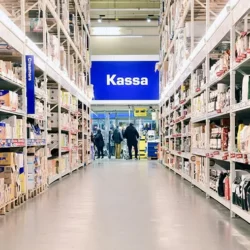COVID-19 pandemic exposes need for central management of healthcare supply chain

The healthcare sector is lagging behind when it comes to supply chain management, yet the potential savings run into billions. So what lessons can be learned from the coronavirus crisis in terms of coordinating resources and managing the availability of hospital beds?
The stakes are high. In the Netherlands, hospitals account for more than €30 billion of the annual €100 billion healthcare spend and employ around 300,000 people. But due to the aging population, hospitals are at serious risk of facing worker shortages and financial problems, with healthcare potentially becoming unaffordable.
In 2003, a report called ‘Faster, Better’ by the then-TPG chairman Peter Bakker calculated that improving logistics could reduce healthcare costs by 20 to 25% without compromising on the quality of care. “A lot of progress has been made in logistics since then,” says Jan Scheffer, an independent Dutch consultant and expert in healthcare logistics. “Numerous improvement initiatives have saved costs, but the healthcare supply chain has also become more complex. I would estimate that the healthcare sector could now save around a further 15%. And based on my calculations, it’s certainly realistic to save over a billion euros in terms of hospitals alone.”
One way to achieve substantial cost reductions would be to integrate purchasing, inventory management, warehouses and internal distribution, says Martijn van Berg, a supply chain specialist from the Netherlands who, for his master’s thesis, conducted research among six hospitals. One of his recommendations was to establish a Cross Chain Control Centre that directs the entire internal supply chain within a hospital. At the Dijklander Hospital, where he now works, the inventory levels in the departmental warehouses are managed centrally. But the nurses are often responsible for keeping the storerooms in their own departments well stocked and they create buffers to ensure they can maintain the best possible level of care. “If this were managed integrally by one department, those buffers would not be necessary at all and you would achieve the same availability with much less stock,” he says. “Plus the healthcare professionals would have more time to focus on their core tasks.”
Fragmented
Frits van Merode, a Dutch professor of operations management and logistics in healthcare at Maastricht University, explains that many of the problems stem from different managers being responsible for different goods flows, such as medicines, disposables, operating rooms and food: “Purchasing departments negotiate on price, but do not make agreements with suppliers about delivery schedules. Materials often arrive in bulk, after which Logistics must find the storage space for them. This leads to high stock levels and unnecessary occupation of expensive square meters. Materials management and just-in-time delivery, as seen for example in the automotive industry, are completely absent in hospitals.”
SKU rationalization
According to Bas Mulder from logistics service provider Hospital Logistics, SKU rationalization can also result in substantial savings. “Individual healthcare professionals have their own preferences for instruments and materials, which often results in hospitals buying many variants of the same item, resulting in very complex sourcing and inventory situations. But the doctors often have the final say, so it can be difficult to push through changes.” This is echoed by Frans Reumkens who was director of Auxilia Zorglogistiek, one of the first collaborations in healthcare logistics, between 2006 and 2009. “Decision-making in a hospital takes place on many levels. You talk to the Board of Directors about rationalizing assortments, but everyone within a hospital can have their say, it seems. As Auxilia we achieved some great things, such as the central supply of hospitals and the improvement of internal logistics, but we did not get anywhere by bundling purchasing flows and harmonizing ranges.”
Collaborative initiatives
There are signs that hospitals are taking supply chain management increasingly seriously and there are already some examples of hospitals pooling their purchasing and logistics strengths to save costs, such as the five-hospital collaborative partnership called ZorgserviceXL in the Netherlands. The firm Hospital Logistics is helping some hospitals to professionalize their logistic by setting up Vendor Managed Inventory-like partnerships in which suppliers of high-quality disposables and implants take care of restocking the departmental storerooms.
Control tower
According to Kjeld Aij, a director at Erasmus Medical Center in Rotterdam, the COVID-19 outbreak laid bare the need for a more centralized approach. There was a sudden acute shortage of all kinds of supplies, but no one knew what was in stock. In the Netherlands, the National Consortium for Medical Devices (LCH) was set up to centrally monitor the availability of goods, source items and optimally (re)distribute stock among the country’s hospitals. “One of the lessons learned during the pandemic is that hospitals can purchase more intelligently and efficiently if one party takes the lead,” he says.
Erasmus MC implemented a new inventory management system, Slim4 from Slimstock, which now integrally manages medical supplies inventories. “With Slim4 we can now see at a glance what is needed. I also want to use this system for departments that still manage their own stocks, such as the laboratories. It is also much easier to combat wastage. At the moment we have no idea what is being thrown away at departmental level, but I suspect that it is considerable,” says René Dullaart, Purchasing Manager.
Control tower-like solution
Kjeld Aij sees possibilities for a control tower-like solution to better allocate the available care capacity to patients. “Within Erasmus MC we have a dashboard that shows us exactly which department has bed, treatment or laboratory capacity available. This has enabled us to increase our internal bed occupancy by as much as 10%, which can generate millions in extra turnover on an annual basis.”
Although he is in favour of more supply chain management, Frank de Reij, former Chief Procurement Officer at KLM and now CEO of Meander Medical Centre in Amersfoort, is absolutely not in favour of a central control tower in which hospitals share information and work together. “That would be far too complex and you would never have the purchasing and planning capabilities at a central level that you do locally. Our experiences of national cooperation during the pandemic have only confirmed this for me: central purchasing and the distribution of patients was an extremely difficult process,” he states.










